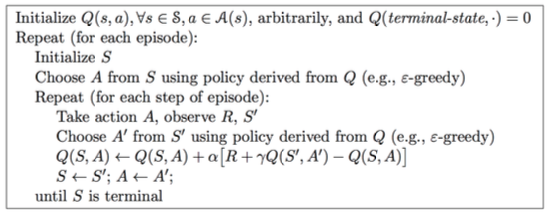上篇总结了 Model-Free Predict 问题及方法,本文内容介绍 Model-Free Control 方法,即 "Optimise the value function of an unknown MDP"。
在这里说明下,Model-Free Predict/Control 不仅适用于 Model-Free 的情况,其同样适用于 MDP 已知的问题:
- MDP model is unknown, but experience can be sampled.
- MDP model is known, but is too big to use, except by samples.
在正式介绍 Model-Free Control 方法之前,我们先介绍下 On-policy Learning 及 Off-policy Learning。
On-policy Learning vs. Off-policy Learning
On-policy Learning:
- "Learn on the job"
- Learn about policy (pi) from experience sampled from (pi)(即采样的策略与学习的策略一致)
Off-policy Learning:
- "Look over someone's shoulder"
- Learn about policy (pi) from experience sampled from (mu)(即采样的策略与学习的策略不一致)
On-Policy Monte-Carlo Learning
Generalized Policy Iteration
具体的 Control 方法,在《动态规划》一文中我们提到了 Model-based 下的广义策略迭代 GPI 框架,那在 Model-Free 情况下是否同样适用呢?
如下图为 Model-based 下的广义策略迭代 GPI 框架,主要分两部分:策略评估及基于 Greedy 策略的策略提升。
Model-Free 策略评估
在《Model-Free Predict》中我们分别介绍了两种 Model-Free 的策略评估方法:MC 和 TD。我们先讨论使用 MC 情况下的 Model-Free 策略评估。
如上图GPI框架所示:
- 基于 (V(s)) 的贪婪策略提升需要 MDP 已知:
- 基于 (Q(s, a)) 的贪婪策略提升不需要 MDP 已知,即 Model-Free:
因此 Model-Free 下需要对 (Q(s, a)) 策略评估,整个GPI策略迭代也要基于 (Q(s, a))。
Model-Free 策略提升
确定了策略评估的对象,那接下来要考虑的就是如何基于策略评估的结果 (Q(s, a)) 进行策略提升。
由于 Model-Free 的策略评估基于对经验的 samples(即评估的 (q(s, a)) 存在 bias),因此我们在这里不采用纯粹的 greedy 策略,防止因为策略评估的偏差导致整个策略迭代进入局部最优,而是采用具有 explore 功能的 (epsilon)-greedy 算法:
因此,我们确定了 Model-Free 下的 Monto-Carlo Control:
GLIE
先直接贴下David的课件,GLIE 介绍如下:
对于 (epsilon)-greedy 算法而言,如果 (epsilon) 随着迭代次数逐步减为0,那么 (epsilon)-greedy 是 GLIE,即:
GLIE Monto-Carlo Control
GLIE Monto-Carlo Control:
- 对于 episode 中的每个状态 (S_{t}) 和动作 (A_t):
- 基于新的动作价值函数提升策略:
定理:GLIE Monto-Carlo Control 收敛到最优的动作价值函数,即:(Q(s, a) → q_*(s, a))。
On-Policy Temporal-Difference Learning
Sarsa
我们之前总结过 TD 相对 MC 的优势:
- 低方差
- Online
- 非完整序列
那么一个很自然的想法就是在整个控制闭环中用 TD 代替 MC:
- 使用 TD 来计算 (Q(S, A))
- 仍然使用 (epsilon)-greedy 策略提升
- 每一个 step 进行更新
通过上述改变就使得 On-Policy 的蒙特卡洛方法变成了著名的 Sarsa。
- 更新动作价值函数
Sarsa算法的伪代码如下:

Sarsa(λ)
n-step Sarsa returns 可以表示如下:
(n=1) 时:(q_{t}^{(1)} = R_{t+1} + gamma Q(S_{t+1}))
(n=2) 时:(q_{t}^{(2)} = R_{t+1} + gamma R_{t+2} + gamma^2 Q(S_{t+2}))
...
(n=infty) 时:(q_{t}^{infty} = R_{t+1} + gamma R_{t+2} + ... + gamma^{T-1} R_T)
因此,n-step return (q_{t}^{(n)} = R_{t+1} + gamma R_{t+2} + ... + gamma^{n}Q(S_{t+n}))
n-step Sarsa 更新公式:
具体的 Sarsa(λ) 算法伪代码如下:

其中 (E(s, a)) 为资格迹。
下图为 Sarsa(λ) 用于 Gridworld 例子的示意图:
Off-Policy Learning
Off-Policy Learning 的特点是评估目标策略 (pi(a|s)) 来计算 (v_{pi}(s)) 或者 (q_{pi}(s, a)),但是跟随行为策略 ({S_1, A_1, R_2, ..., S_T}simmu(a|s))。
Off-Policy Learning 有什么意义?
- Learn from observing humans or other agents
- Re-use experience generated from old policies (pi_1, pi_2, ..., pi_{t-1})
- Learn about optimal policy while following exploratory policy
- Learn about multiple policies while following one policy
重要性采样
重要性采样的目的是:Estimate the expectation of a different distribution。
Off-Policy MC 重要性采样
使用策略 (pi) 产生的 return 来评估 (mu):
朝着正确的 return 方向去更新价值:
需要注意两点:
- Cannot use if (mu) is zero when (pi) is non-zero
- 重要性采样会显著性地提升方差
Off-Policy TD 重要性采样
TD 是单步的,所以使用策略 (pi) 产生的 TD targets 来评估 (mu):
- 方差比MC版本的重要性采样低很多
Q-Learning
前面分别介绍了对价值函数 (V(s)) 进行 off-policy 学习,现在我们讨论如何对动作价值函数 (Q(s, a)) 进行 off-policy 学习:
- 不需要重要性采样
- 使用行为策略选出下一步的动作:(A_{t+1}simmu(·|S_t))
- 但是仍需要考虑另一个后继动作:(A'simpi(·|S_t))
- 朝着另一个后继动作的价值更新 (Q(S_t, A_t)):
讨论完对动作价值函数的学习,我们接着看如何通过 Q-Learning 进行 Control:
- 行为策略和目标策略均改进
- 目标策略 (pi) 以greedy方式改进:
- 行为策略 (mu) 以 (epsilon)-greedy 方式改进
- Q-Learning target:
Q-Learning 的 backup tree 如下所示:
关于 Q-Learning 的结论:
Q-learning control converges to the optimal action-value function, (Q(s, a)→q_*(s, a))
Q-Learning 算法具体的伪代码如下:
对比 Sarsa 与 Q-Learning 可以发现两个最重要的区别:
- TD target 公式不同
- Q-Learning 中下一步的动作从行为策略中选出,而不是目标策略
DP vs. TD
两者的区别见下表:
Reference
[1] Reinforcement Learning: An Introduction, Richard S. Sutton and Andrew G. Barto, 2018
[2] David Silver's Homepage